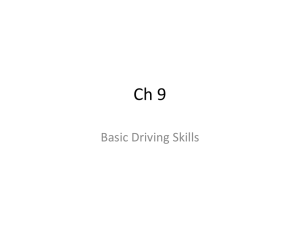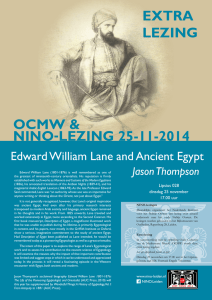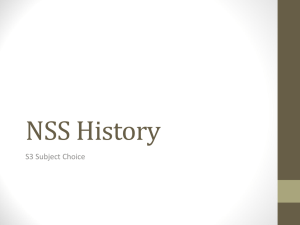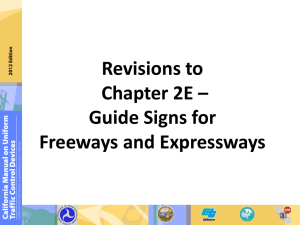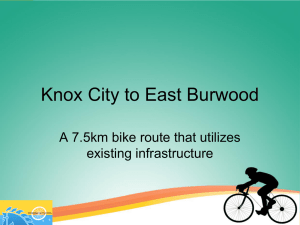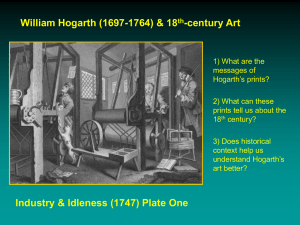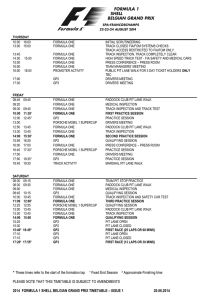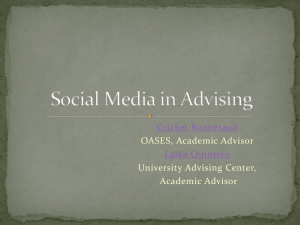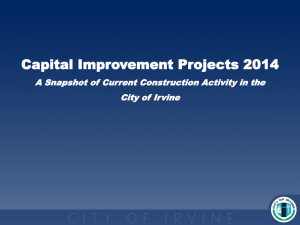to OACTE on Best Practices
advertisement
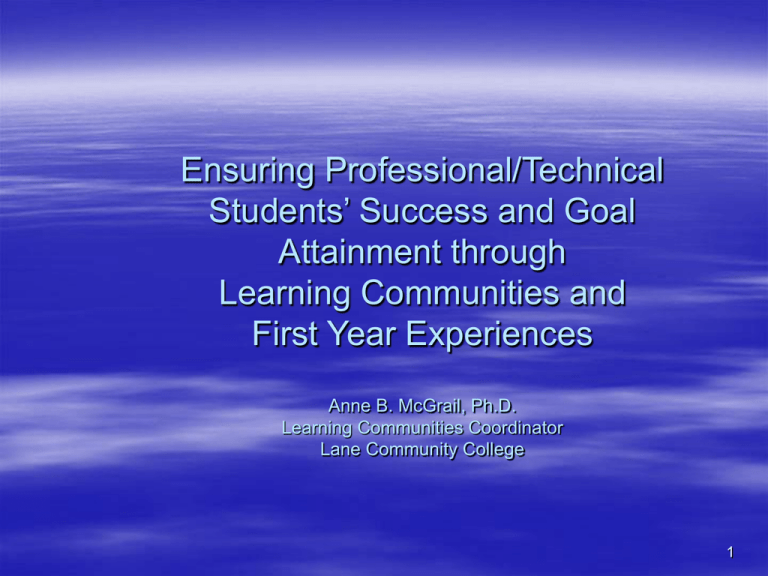
Ensuring Professional/Technical Students’ Success and Goal Attainment through Learning Communities and First Year Experiences Anne B. McGrail, Ph.D. Learning Communities Coordinator Lane Community College 1 Overview Six Best Practices for Student Retention and Success Learning Communities at Lane Success and Goal Attainment Committee Developing a Comprehensive First Year Experience Infusing College Success Principles and Strategies into Learning Communities and Classes to Increase Student Engagement, Learning, Satisfaction and Success 2 Six Best Practices Learning Communities First Year Experiences Academic Advising Supplemental Instruction Early Warning/Intervention Systems Campus Climate/Supportive Learning Environment 3 Learning Communities (LCs) at Lane Begun in 1994 with one class of 30 students Currently serves 1,000 students per year “Boutique Model” of theme-based classes encouraged early faculty adoption of the LC model 4 Disadvantages of “Boutique” Model Faculty “ownership” of the LC Dependent upon ongoing faculty engagement (burnout) Enrollment challenges brought about by structure (classes offered targeted a smaller population of Lane’s students) 5 Development of Learning Communities Some LCs have systematically addressed specific student needs: – Women in Transition – BioBonds: Biology and Chemistry for the Health Professions – $how Me the Money! Writing for Scholarships – Food for Thought: Culinary Arts and Writing and Math 6 Learning Community Arrangments Best Practice: tightly aligned curriculum with pure cohorts and faculty at least some of the time present in each other’s classes or engaged in cross-disciplinary learning activities (e.g., Service Learning, Reading Together—more later on these) 7 Other Arrangements One “common” class with three “feeder” classes with same material 8 Other Arrangements Three separate classes with mixed cohorts taking two or more but some taking only one class. 9 Other Arrangements Two “feeder” classes with a pure cohort and a third separate class. (This is the current plan for a Math addition to Fast Lane.) + e.g., Math 10 or + Math 65 or + Math 111 10 Success and Goal Attainment Committee (SAGA) Chartered group of Student Services professionals at Lane whose goal was to increase student success and retention Created the “SAGA Report” in 2002 which outlined Six Best Practices for Retention and Success. 11 The First Year Experience: Synergy of Learning Communities Development with SAGA Efforts: Learning Communities developed beyond “boutique” model to a systematic effort to address students’ needs. SAGA research showing LCs as a Best Practice has given momentum to tailoring different FYEs to different programs, including P/T. Better integration of instruction with student services has been the result of the two programs coordinating their goals. 12 Development of First Year Learning Community “Fast Lane to Success” addresses the academic and social learning needs of new Lane students – “On Course: College Success” – Effective Learning – Writing 13 Fast Lane to Success Curricular coordination, ongoing faculty conversations about the LC, and regular communication with students develops a “community” of learners who help one another succeed. 14 Other Components of Fast Lane to Success Paid peer mentor with successful experience in Fast Lane In-class counseling and advising to ensure correct pathway to degree/certificate Mid-term grade reports and “intrusive” advising E-portfolios that will move through college with the student Follow-up mentoring and study-groups throughout the first year. 15 Assessments of Students and the Fast Lane Program Risk-assessment (Noel-Levitz College Student Inventory indicates risk areas) Survey of Engagement with College-Wide CCSSE as control group (positive effects) Pre-and-post tests Tracking students on persistence and success across time FYRED UP! Pilot Project Team yearly assessments 16 Fast Lane to Success Assessment Inspired by the Community College Survey of Student Engagement, asked questions on a 4point scale about student engagement with the LC. Compared Fast Lane engagement returns to 800 “general population” answers from students Fast Lane students fared significantly better on many measures of engagement (a key predictor of success) Caveat: Small sample: 62 students 17 Assessments Currently developing a qualitative and quantitative “economic impact” and “learning impact” assessment that will serve as a model for innovative learning projects across the college. Noel Levitz has a formula for assessing the economic impact of retention efforts. 18 Scaffolding Beyond Fast Lane: Other LCs Food for Thought: Designed for Culinary Arts students – Culinary Arts classes in two terms use math and writing skills – Math class engages the content of the culinary program in its case studies and examples. – Writing class uses food writing as the text and also the product of students’ essays. 19 Other Learning Communities “BioBonds: Building Blocks of Your Body” provides Health Professions students with fundamental biology and chemistry courses that serve as the prerequisite to Anatomy and Physiology Specifically addresses the failure rate of underprepared Anatomy and Physiology students. 20 Other Learning Communities $how Me the Money! Writing for Scholarships Guides students through a process of uncovering their skills and talents and develop their ideas in writing through the state-wide scholarship application. Thousands of dollars of scholarship money, including a Ford Fellow have resulted. 21 Best Practice: Academic Advising Students are more likely to be successful and to experience less frustration with the hurdles of college requirements if they have a plan in place and follow it Encouraging and facilitating advising for every student is a goal of FYE at Lane “Doing Advising Differently”: may be necessary to do group advising, etc. 22 Best Practice: Supplemental Instruction For “gateway” classes Similar to tutoring Credit or non-credit options Study groups/classes meet outside of anchor course Facilitator/instructor works with difficult material from the anchor course Additional time on task allows for enhanced learning 23 Best Practice: Early Warning/Intervention Systems Goal is to communicate to student their risk of failing before it’s too late Use of Banner to provide advisors data on at-risk students Early intervention by advisors and/or faculty to allow students to catch up or make changes needed to succeed. Back on Course Pilot Project to help students at risk of losing financial aid. 24 Best Practice: Campus Climate: Supportive Learner Environment Orientations Lane Preview Night Students First centralized services Using Community College Survey of Student Engagement (CCSSE) to gauge to what extent students are using advising, tutoring and other support services. 25 New Best Practice: Placement and Preparedness Developing new placement testing that more accurately places students in courses in which they are prepared enough to succeed In “open access” environment, giving students the “right to succeed” rather than the “freedom to [choose the wrong courses and] fail.” 26 Infusion Model: Using College Success Principles in All Classes Getting on Course Accepting Personal Self-Responsibility Discovering Self-Motivation Mastering Self-Management – Tools include a Next Actions list; a 32 day commitment worksheet; a calendar and a financial plan; Learning tools for internal/external distractors; An interactive time chart Employing Interdependence Gaining Self-Awareness Adopting Lifelong Learning Developing Emotional Intelligence Staying on Course 27 Career and Technical Students: Why Learning Communities and FYE? Need to tailor services to specific needs of PT students Currently a technical writing course infused with College Success principles has shown promise Importance of guiding and supporting students whose schedules are tight with required skills and content classes. 28 “School Doesn’t Get Any Better than This!” –Lane Learning Community Student Questions? Anne McGrail Coordinator, Learning Communities Lane Community College 541-463-3317 mcgraila@lanecc.edu 29
